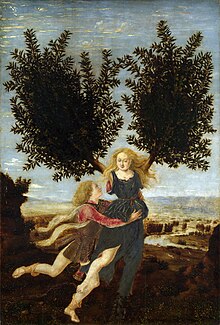Apollo and Daphne
That one is suited to my shoulders, since I can hit wild beasts of a certainty, and wound my enemies... You should be intent on stirring the concealed fires of love with your burning brand, not laying claim to my glories!"Eros, angered by Apollo's implication that one god's abilities could be greater or lesser than another's, flies to the peak of Mount Parnassus then draws and fires two arrows: "one kindles love, the other dispels it."[12] Having taken after Apollo's sister, Artemis (Diana), Daphne spurned her many potential lovers, preferring instead to spend her times in the woods, exploring the forest and hunting.No sooner than the cry left her mouth she felt "a heavy numbness seized her limbs, thin bark closed over her breast, her hair turned into leaves, her arms into branches, her feet so swift a moment ago stuck fast in slow-growing roots, her face was lost in the canopy."He says that he will wear her leaves in his hair, will use her wood to make his bow and lyre, and that a crown made of her branches will adorn the heads of royalty and champions of game and battle.[1] Like the Apollo and Daphne frescoes from Pompeii (such as the one illustrated above), the Gandharan dishes do not depict "the kind of full-blown, full-flight transformational image based on Ovid that is so familiar from Renaissance, Baroque, and later art," because they reflect earlier sources.Instead of a chase concluding with a transformation initiated by a paternal water god, pre-Ovidian versions might have used a substitution, with Daphne swallowed up by the earth (her mother Gaia).[13][14] In Piero Pollaiolo's painting Apollo and Daphne (National Gallery, London), both protagonists are shown dressed in Renaissance garments, endowing this version of the theme with a courtly character.[3] Between 1622 and 1625, Gian Lorenzo Bernini helped to inaugurate the age of Baroque sculpture with his life-sized marble statue Apollo and Daphne (Borghese Museum), which is arguably the most remarkable, influential, and impressive version of this theme.[17] The Rococo artist François Boucher made a chalk drawing of Apollo and Daphne (c. 1730s, private collection) in which one of her feet rests on her father's body as her arms blossom into branches and leaves.[1] Milet Andrejevic, a Yugoslavian immigrant to the U.S., set his Apollo and Daphne (1969, Rhode Island School of Design Museum, Providence) in New York's Central Park.[1] Boris Vallejo, the Peruvian-born fantasy painter, based his Daphne and Apollo (1989, private collection) on Arnold Schwarzenegger and Sandahl Bergman, the warrior queen Valeria from the film Conan the Barbarian (1982).[1] Ivan Bubentcov, a Russian painter influenced by Tom of Finland, made a queer version of the Apollo and Daphne myth by synthesizing it with the Pygmalion story.



Apollo and Daphne (disambiguation)PompeiiApolloDaphneAncient Greek transformation or metamorphosis mythGreek mythologyHellenisticvignettelaurel treePartheniusMetamorphosesDelphiPythian GamespatronArtemisPeneusCreusaJupiterepithetPythonoraclePythiaMount ParnassusClarosTenedosPataraGian Lorenzo BerniniApollo and DaphnelaurelGandharaMetropolitan Museum of ArtAntiochCorning Museum Of GlassPiero del PollaiuoloAntonio del Pollaiuolo(National Gallery, LondonRenaissanceSchiavoneBaroqueNicolas Poussinwork on the subjectAlte PinakothekMassimiliano Soldani BenziterracottaCleveland Museum of ArtClevelandRococoFrançois BoucherGiovanni Battista TiepoloLouvreNational Gallery of ArtThe KissGustav KlimtJohn William WaterhousePre-RaphaeliteMeret OppenheimMilet AndrejevicRhode Island School of DesignCentral ParkBoris VallejoArnold SchwarzeneggerSandahl BergmanConan the BarbarianTom of FinlandPygmalion
